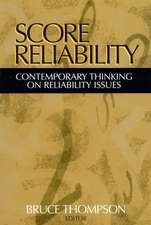Presenting Statistical Results Effectively
Autor Robert Andersen, David A. Armstrong IIen Limba Engleză Paperback – 19 dec 2021
Focused on best practices for building statistical models and effectively communicating their results, this book helps you:
- Find the right analytic and presentation techniques for your type of data
- Understand the cognitive processes involved in decoding information
- Assess distributions and relationships among variables
- Know when and how to choose tables or graphs
- Build, compare, and present results for linear and non-linear models
- Work with univariate, bivariate, and multivariate distributions
- Communicate the processes involved in and importance of your results.
Preț: 363.62 lei
Nou
Puncte Express: 545
Preț estimativ în valută:
69.58€ • 74.40$ • 58.01£
69.58€ • 74.40$ • 58.01£
Carte disponibilă
Livrare economică 27 martie-10 aprilie
Livrare express 13-19 martie pentru 50.68 lei
Preluare comenzi: 021 569.72.76
Specificații
ISBN-13: 9781446269817
ISBN-10: 1446269817
Pagini: 456
Dimensiuni: 189 x 246 x 23 mm
Greutate: 0.81 kg
Ediția:1
Editura: SAGE Publications
Colecția Sage Publications Ltd
Locul publicării:London, United Kingdom
ISBN-10: 1446269817
Pagini: 456
Dimensiuni: 189 x 246 x 23 mm
Greutate: 0.81 kg
Ediția:1
Editura: SAGE Publications
Colecția Sage Publications Ltd
Locul publicării:London, United Kingdom
Recenzii
Is your quantitative work so screamingly clear that your readers never misunderstand your figures, misread your tables, or get confused by your prose? If so, then don't waste your time with Andersen and Armstrong's thoughtful book about the effective presentation and interpretation of statistical results.
Cuprins
Chapter 1: Some Foundation
What is a ‘Model’?
Statistical Inference
Part A: General Principles of Effective Presentation
Chapter 2: Best Practices for Graphs and Tables
When to use Tables and Graphs
Constructing Effective Tables
Constructing Clear and Informative Graphs
Chapter 3: Methods for Visualizing Distributions
Displaying the Distributions of Categorical Variables
Displaying Distributions of Quantitative Variables
Transformations
Chapter 4: Exploring and Describing Relationships
Two Categorical Variables
Categorical Explanatory Variable and Quantitative Dependent Variable
Two quantitative Variables
Multivariate Displays
Part B: The Linear Model
Chapter 5: The Linear Regression Model
Ordinary Least Squares Regression
Hypothesis tests and confidence intervals
Assessing and Comparing Model Fit
Relative Importance of Predictors
Interpreting and presenting OLS models: Some empirical examples
Linear Probability Model
Chapter 6: Assessing the Impact and Importance of Multi-category Explanatory Variables
Coding Multi-category Explanatory Variables
Revisiting Statistical Significance: Multi-category Predictors
Relative importance of sets of regressors
Graphical Presentation of Additive Effects
Chapter 7: Identifying and Handling Problems in Linear Models
Nonlinearity
Influential Observations
Heteroskedasticity
Nonnormality
Chapter 8: Modelling and Presentation of Curvilinear Effects
Curvilinearity in the Linear Model Framework
Nonlinear Transformations
Polynomial Regression
Regression Splines
Nonparametric Regression
Generalized Additive Models
Chapter 9: Interaction Effects in Linear Models
Understanding Interaction Effects
Interactions Between Two Categorical Variables
Interactions Between One Categorical Variable and One Quantitative Variable
Interactions Between Two Continuous Variables
Interaction Effects: Some Cautions and Recommendations
Part C: The Generalized Linear Model and Extensions
Chapter 10: Generalized Linear Models
Basics of the Generalized Linear Model
Maximum Likelihood Estimation
Hypothesis tests and confidence intervals
Assessing Model Fit
Empirical Example: Using Poisson Regression to Predict Counts
Understanding Effects of Variables
Measuring Variable Importance
Model Diagnostics
Chapter 11: Categorical Dependent Variables
Regression Models for Binary Outcomes
Interpreting Effects in Logit and Probit Models
Model Fit for Binary Regression Models
Diagnostics Specific to Binary Regression Models
Extending the Binary Regression Model – Ordered and Multinomial Models
Chapter 12: Conclusions and Recommendations
Choosing the Right Estimator
Research Design and Measurement Issues
Evaluating the Model
Effective Presentation of Results
What is a ‘Model’?
Statistical Inference
Part A: General Principles of Effective Presentation
Chapter 2: Best Practices for Graphs and Tables
When to use Tables and Graphs
Constructing Effective Tables
Constructing Clear and Informative Graphs
Chapter 3: Methods for Visualizing Distributions
Displaying the Distributions of Categorical Variables
Displaying Distributions of Quantitative Variables
Transformations
Chapter 4: Exploring and Describing Relationships
Two Categorical Variables
Categorical Explanatory Variable and Quantitative Dependent Variable
Two quantitative Variables
Multivariate Displays
Part B: The Linear Model
Chapter 5: The Linear Regression Model
Ordinary Least Squares Regression
Hypothesis tests and confidence intervals
Assessing and Comparing Model Fit
Relative Importance of Predictors
Interpreting and presenting OLS models: Some empirical examples
Linear Probability Model
Chapter 6: Assessing the Impact and Importance of Multi-category Explanatory Variables
Coding Multi-category Explanatory Variables
Revisiting Statistical Significance: Multi-category Predictors
Relative importance of sets of regressors
Graphical Presentation of Additive Effects
Chapter 7: Identifying and Handling Problems in Linear Models
Nonlinearity
Influential Observations
Heteroskedasticity
Nonnormality
Chapter 8: Modelling and Presentation of Curvilinear Effects
Curvilinearity in the Linear Model Framework
Nonlinear Transformations
Polynomial Regression
Regression Splines
Nonparametric Regression
Generalized Additive Models
Chapter 9: Interaction Effects in Linear Models
Understanding Interaction Effects
Interactions Between Two Categorical Variables
Interactions Between One Categorical Variable and One Quantitative Variable
Interactions Between Two Continuous Variables
Interaction Effects: Some Cautions and Recommendations
Part C: The Generalized Linear Model and Extensions
Chapter 10: Generalized Linear Models
Basics of the Generalized Linear Model
Maximum Likelihood Estimation
Hypothesis tests and confidence intervals
Assessing Model Fit
Empirical Example: Using Poisson Regression to Predict Counts
Understanding Effects of Variables
Measuring Variable Importance
Model Diagnostics
Chapter 11: Categorical Dependent Variables
Regression Models for Binary Outcomes
Interpreting Effects in Logit and Probit Models
Model Fit for Binary Regression Models
Diagnostics Specific to Binary Regression Models
Extending the Binary Regression Model – Ordered and Multinomial Models
Chapter 12: Conclusions and Recommendations
Choosing the Right Estimator
Research Design and Measurement Issues
Evaluating the Model
Effective Presentation of Results
Descriere
Perfect for any statistics student or researcher, this book offers hands-on guidance on interpreting, analysing, and presenting results to achieve maximum impact.













